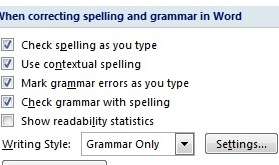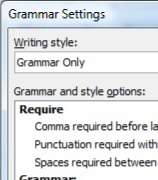In Right like a Writer, I mentioned how a list of items should include a comma after every item except the last, including after and or or, and how you should only use one space after a period, rather than two. All versions of Microsoft Word can be configured to monitor for both of these using the grammar settings built in to the application; it will identify violations during regular grammar checks. Here's how to enable these options in MSWord 2007: - Access Word Options

Access Word Options by clicking the Office Button in Microsoft Word (the Office logo in the top-left corner of the window), and click on the Word Options button in the lower-right corner of the menu popup. The Word Options window should display. - Access Proofing Settings
In the Word Options window, access proofing settings by clicking Proofing on the left-side navigation. - Access Grammar Settings

Once you are in Proofing settings, you will find Grammar Settings by clicking the Settings... button next to Writing Style. Writing Style can be found under the Proofing section titled When correcting spelling and grammar in Word.
- Use Only One Space

In the Grammar Settings window, the number of spaces after a period is controlled by the option titled Spaces required between sentences. This is set to don't check by default, but options for 1 space and 2 spaces are available. Set this option to 1. - Include a Comma Before the Last Item
Also in the Grammar Settings window, check for commas after and and or through the field titled Comma required before last list item. This is also set to don't check by default, though always and never are available options. Set this option to always.
Additionally, the style checks available through Word's Grammar Settings can also be very helpful. I prefer the "Grammar and Style" writing style option, as it enables all of the style checks. I encourage you to investigate all of these options, as well as enable the comma and sentence options, as they will help you write right like a writer.
At the devLink Technical Conference, one of the Open Spaces focused on Computer Science curriculum at universities, and what things that the developer community would CRUD on the CompSci tradition. Though I did not have opportunity to participate in the discussion—I was facilitating an Open Space on Continuous Integration, next door—I do have one proposal: "Writing." For Computer Scientists—a traditionally introverted and communication-challenged group—programming in English (substitute with your native language) should be paramount. Communicating to humans is part of our job description, and we must be able to do so effectively and using their language, whether it be for status updates, business justifications, SOWs, proposals, or just another email. Developers need to communicate effectively; write well rather than write good. We must be right like a writer.
We programmers should write like we code. The written word should be concise, to the point, just like code. Coders do not frivolously use fancy namespaces and complicated classes so that their code looks smart, as it has the opposite effect by resulting in bloated, inefficient, unmaintainable systems. Big words implemented frivolously for the sake of sounding smart perform the opposite function, and likewise result in bloated, inefficient, unmaintanable text. We avoid power robbers in our code, such as using string builders rather than underperforming string concatenations, and should avoid similar performance kills in our writing. Additionally, using the wrong keyword in code, or misusing grammatical marks in our code, results in compiler errors or runtime errors. The written word—a language void of any compiler benefits—throws runtime exceptions on execution when it is improperly authored, much like JavaScript or XSL.
“Vigorous writing is concise. A sentence should contain no unnecessary words, a paragraph no unnecessary sentences, for the same reason that a drawing should have no unnecessary lines and a machine no unnecessary parts. This requires not that the writer make all sentences short or avoid all detail and treat subjects only in outline, but that every word tell.” — William Strunk
But like a programming language, English is simply a matter of keywords and laws. We must learn the rules of the system; we must learn its syntax; we must learn how to test and validate our code before shipping it off to a client or to production. Approaching the English language like we approach a programming language would also provide an effective learning mechanism for us developer-types. This would make an effective course at university: "Writing : For Programmers." Learn English like we learn any other language—approach it using our virtues—as what works for us may not be the same path that works for an English major.
Throughout my career, I have noticed a few areas that are typically mis-coded. I have included a few items below that every developer should be aware of to help learn English's keywords, its laws, and to provide opportunities to improve end-user experience.
Knowing the Language at an Elementary Level
- Homonyms : words that sound the same but can mean different things. This is often a challenge for people new to English, but even veterans get confused. Everyone should learn the difference, and make proper use a habit. And proof read, as spell check will not catch misuse of homonyms. This applies to:
- Their / There / They're
- To / Too / Two
- Your / You're
- Its / It's
- Hear / Here
- Threw / Through
- Write / Right
- Irregardless is not a word.
- Who vs. Whom : Who, the subject, is doing the acting, and whom, the object, is being acted upon. The shortcut is to use who and whom as you would he and him. (Remember that him and whom both end in "m".) <Who did what to whom for how many jellybeans? He did that to him for five jellybeans.>
- Me vs. I : Follow the same rules as for who vs. whom, above. The subject is doing the acting, and the object is being acted upon. Subject pronouns are I, he, she, we, they, and who. Object pronouns are me, him, her, us, them, and whom. <Sally gave me five dollars. I used to money to buy lunch.>
- Than vs. Then : A comparison (than) vs. a measure of time (then). In code, than is used when describing a comparison operator; the '>' operator is a greater-than operator. In code, time sequences are an if...then statement. <Apples are better than oranges. I will eat my apple first, then I will eat my orange.>
Knowing the Language at a High School Level
- Power Robbers : Never use due to the fact that. It weakens your sentence. Use because.
- Contractions : In formal writing (e.g. Proposals, SOWs), avoid contractions. Contractions are for casual writing. Think along the lines of a Debug Build versus a Release Build.
- Simply & Obviously : Avoid using simply and obviously as it may be both to you, but neither to your audience. If it was simple or obvious, then you didn't need to write it.
- Use one space after a sentence, not two. A PC is not a typewriter. On a typewriter, with fixed-width fonts, two spaces are preferred, but on a PC, True Type fonts will properly space "<dot><space>" for you. Don't believe me? Open up any book and look at the spaces between sentences. Microsoft Word has an option to indicate this for you under grammar preferences.
- Effect vs. Affect : Effect is the result, affect is the action. Noun and verb. <Poor engine performance is the effect of ignored maintenance. Ignoring maintenance affects engine performance.>
Knowing the Language at a Collegiate Level
- Lists : Just like when defining an array, use a comma after every item in a list except the last. This includes before "and." <I like red, white, and blue.>
- i.e. vs. e.g. : The first is in other words and the second is for example, though this does not do much for clarity. Essentially, i.e. is a complete, clarifying list, while e.g. is an incomplete list of examples. <I watch the three stooges (i.e., Larry, Curly, and Moe). I like all four-player card games (e.g., Euchre, Spades, and Hearts).>
- Semicolons : Semicolons are used to separate two independent yet related clauses that could be broken into separate sentences. <The water is very hot; I hope I don't burn myself.> Also, use semicolons to separate items in a list where the items contain commas. <When the cards were dealt, Jack had a straight; Sally had two nines, two fives, and a queen; and George had a full house.>
Be mindful of your native language. It is the one you use the most, even more than C#, or Ruby, or Java. If you don't already own a copy, pick up The Elements of Style by Strunk & White; if you do own a copy, either have it at your desk so you can use it, or give it to someone who will. Effectively communicating with humans, using their rules, will help you have better testing, better design, better requirements, and have a better job. Become an effective English developer, and it will help you be a more effective developer, overall.
Tomorrow night, Thursday, 11 September, I will be speaking at the GLUGnet Flint meeting. We will be discussing Continuous Integration, focusing on CI as a process, not just a toolset. Come out to Flint, enjoy some pizza, and hear about what Continuous Integration can do for your development cycle. Continuous Integration: It's more than just a toolset
Thursday, 11 September, 2008 @ 6:00pm
New Horizons
4488 West Bristol Road
Flint, MI 48507
Session Abstract:
Does your team spend days integrating code at the end of a project? Continuous Integration can help. Using Continuous Integration will eliminate that end-of-project integration stress, and at the same time will make your development process easier. But Continuous Integration is more than just a tool like CruiseControl.Net; it is a full development process designed to bring you closer to your mainline, increase visibility of project status throughout your team, and to streamline deployments to QA or to your client. Find out what Continuous Integration is all about, and what it can do for you.
|